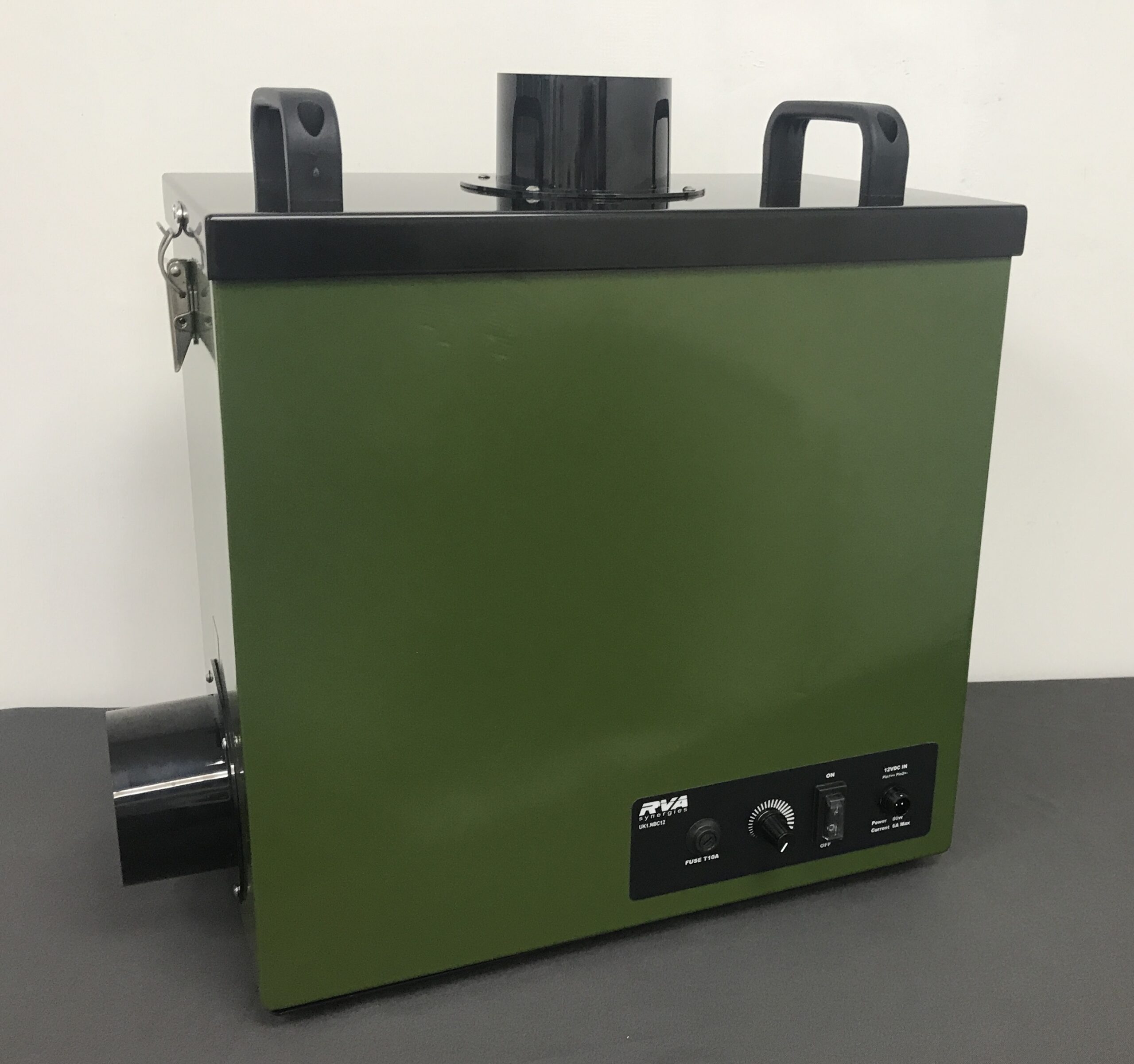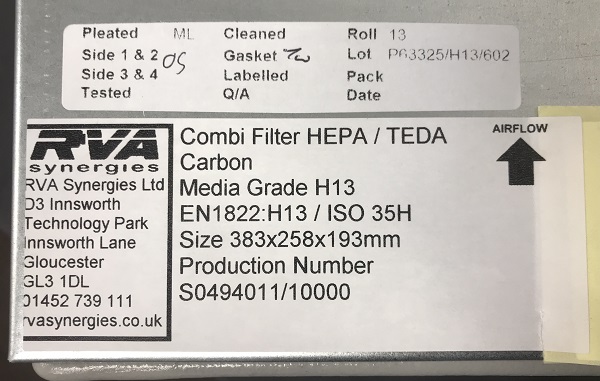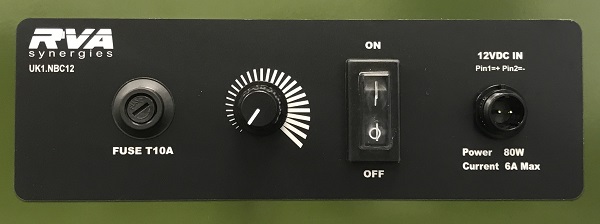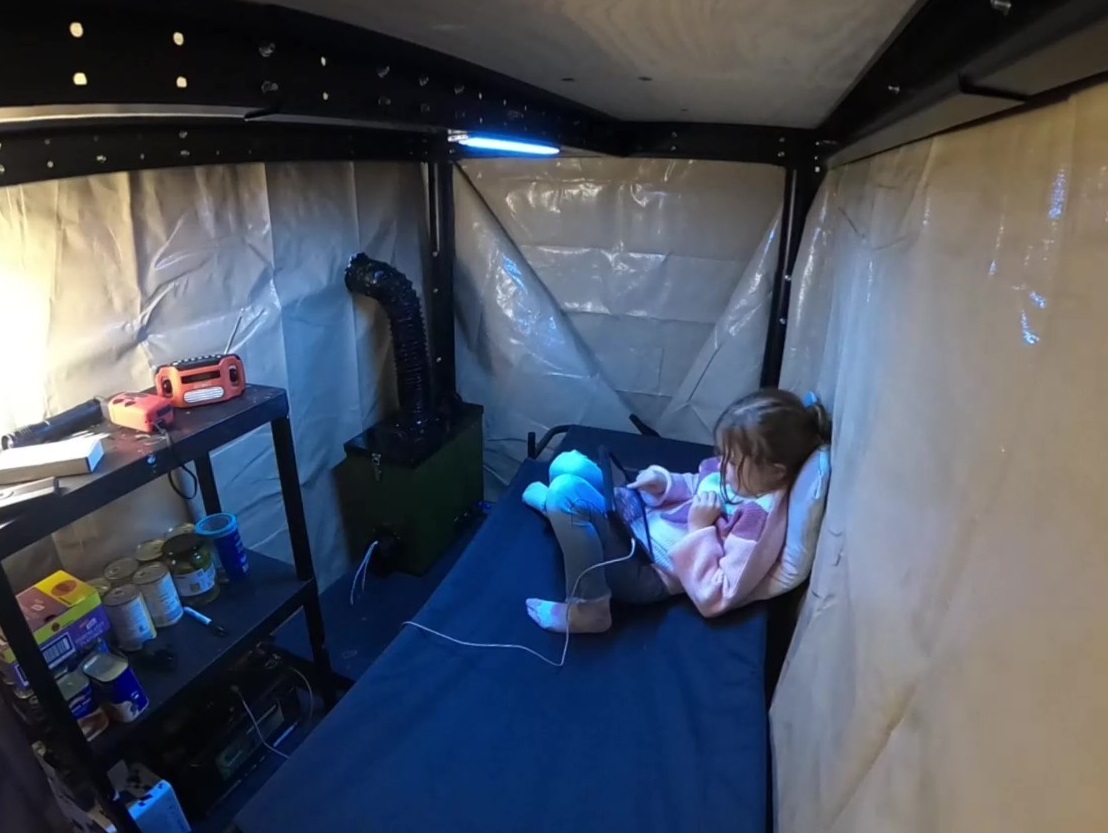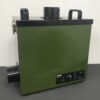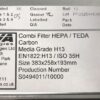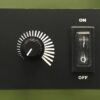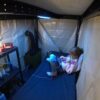- 12VDC – can be used with a range of 12V sources such as car/leisure batteries, solar, wind, pedal and hand crank generators directly.
- Heavy steel construction, yet portable
- Adjustable speed control
- Can be used for various types of emergency shelter
- HEPA 13 99.97% particle removal to EN1822
- Specialist TEDA carbon 5Kgs (11lbs)
- Designed and manufactured in the UK by RVA Synergies Ltd
UK1 12V Air filter for emergency shelters
UK1 12V Air filter for emergency shelters
The UK1 is a 12V Air filter unit designed for domestic use in emergency shelters such as safe rooms, fallout rooms and inner refuges.
In 1980 the Home Office published a booklet called Protect and Survive. The booklet explained how a fallout room and ‘inner refuge’ can be created inside the average British home in the event of a nuclear attack.
Today, the majority of nuclear bunkers that the public know about have been decommissioned, abandoned or repurposed. There is no provision by the UK government to accommodate any of the British public in bunkers during a nuclear attack. When we compare the UK to other European countries, some of which can shelter a large proportion of their population or even their entire population, Britain is woefully unprepared.
Building a bunker in the UK is not something that is practical or affordable to do for the average person. Planning permission means that neighbours would be alerted to one’s intentions long before building is even underway. The bunker builder would become the subject of local attention, and would likely make the newspapers or even national television as the lunatic building a doomsday bunker in their garden. The next best option for protection is a basement, which can be converted by means of a reinforced roof and even a gas tight steel door, with suitable NBC air system. The UK1 air filter would be suitable for this purpose.
For the vast majority, our home is all we have, however if a room or space can be allocated on the ground floor, 3 metres or more from all external walls, then an ‘inner refuge’ could be built. If a house is destroyed in a 5psi blast wave of a nuclear bomb, then an inner refuge and it’s occupants would likely go with it. Perhaps more likely would be that your home is located either not in a blast zone at all, or in the wider 1psi blast zone of a bomb. In this case windows would probably break, with roof and heat damage possible. However if one can seal up broken windows within 10 minutes before fallout may arrive, then an inner refuge with suitable air filter could make the difference between surviving and not surviving.
Such an emergency shelter should be as airtight as possible and it must have a suitable air filter to bring in clean breathable air. It also must create positive pressure, where the pressure inside the shelter is greater than the atmospheric pressure outside of the shelter. The positive pressure (inside air pushing out of the shelter) prevents contaminated air from seeping in from outside through cracks and gaps. As important, positive pressure ensures that exhaled carbon dioxide along with unwanted odours, is pushed out.
The portable UK1 consists of a tough powder coat painted heavy duty steel enclosure containing a fan, adjustable speed controller and specially made replaceable filter block.
The filter block is comprised of in sequence: a pre filter, a HEPA 13 filter, which removes 99.97% of particles down to 0.3 micron and a TEDA carbon filter containing 5kgs (11lbs) of carbon. TEDA carbon is a special type of carbon used in the nuclear industry that is impregnated with Triethlyenediamine, which by the process of adsorption removes radioactive iodine and methyl iodine from passing air.
Air flow measurements through the UK1 are given in CFM (cubic feet per minute). The maximum output of the UK1 is 65 CFM. The amount of air that an adult breathes is no more than 5 CFM.
Therefore theoretically 65 CFM could provide air for up to 13 people. In practice the UK1 is intended for use by small families, where 4 people may only require ~25 CFM. Also one must overestimate the amount of air that is required because there may be losses in the shelter system. An ultra-safe calculation would be to provide 10 CFM per person. As noise reduction is important wherever possible, the UK1 can be turned down to a more comfortable level with the built-in speed controller.
In the event of a nuclear attack an EMP (Electro-magnetic pulse) needs to be considered. The UK1 contains electrical circuitry that is deliberately low tech, avoiding LCD screens, timers and anything requiring microelectronics that is most vunerable to EMP.
The unit itself provides a degree of EMP protection because it is a solid steel enclosure. *Albeit with a 100mm hole in the top and side.
The UK1 comprises:
UK1 Main unit, Filter Block, 1 metres of 100mm ducting, duct clip, 3 metre 12V power cable with unit plug and bare ends (for wiring to your own 12V power supply)
*Please note that we do not currently offer a blast valve or over-pressure valve, which are usually required for purpose-built bunkers / blast shelters. It should be noted that there is a large difference between a blast shelter and a fallout shelter. A blast shelter should be underground and designed to withstand the pressure wave of a nuclear detonation with a minimum of 5 psi. Blast shelters of 20 and 40psi are typical, and these require specialist knowledge and professional build skills, along with adequate blast valves. A fallout shelter on the other hand is a broad term used to describe a shelter that will minimise risk to life from radioactive fallout particles, be that settled particles that are radiating through materials or air-suspended particles that may be inhaled or ingested. Such a shelter requires correct distance positioning, as much dense material protection around it as possible and a sealed positive pressure air filter set up, which is the life support system of a shelter.
| Main Construction: | Steel enclosure, powder coat painted. Quick release cover providing access to replaceable filter block. |
|---|---|
| Filter Construction: | Combined HEPA / TEDA carbon filter block in metal unit with foam gasket on each face |
| Filter Specification: | HEPA 13 to EN1822 standard. 99.97% particle removal to 0.3 micron. TEDA (Triethlyenediamine impregnated) activated carbon granules (coconut shell) 5kgs / 11llbs. |
| Power: | 12VDC 80W / 6A MAX |
| Air output: | 65 CFM MAX, measured at 100mm output duct as 980 ft/min x 0.0666 (Area of duct in ft sq) = 65.2 CFM |
| Residence time: | 0.3 seconds |
| External Testing: | |
| EMC tested in UK for electrical emissions and immunity. CE & UKCA marked. | |
| LEV (Local exhaust ventilation) Thorough examination and testing (TExT) under COSHH regulation 9. | |
| Dimensions: | 425x242x406cms |
| Weight: | 16kgs |

